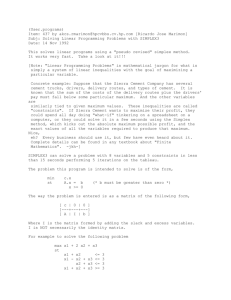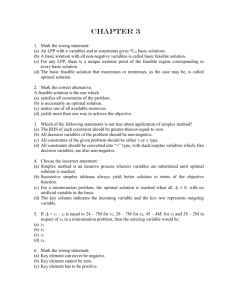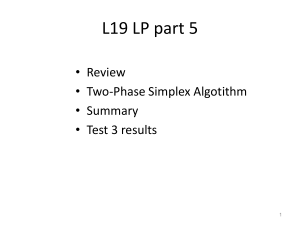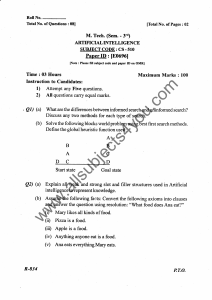PDF only - arXiv.org
advertisement
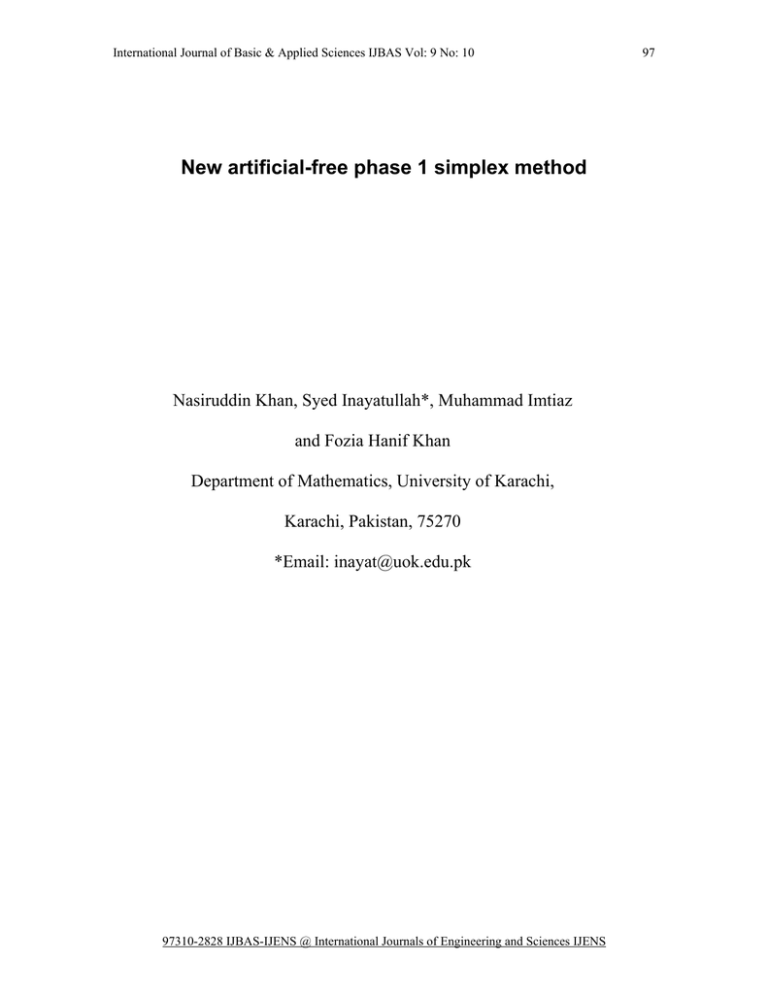
International Journal of Basic & Applied Sciences IJBAS Vol: 9 No: 10
New artificial-free phase 1 simplex method
Nasiruddin Khan, Syed Inayatullah*, Muhammad Imtiaz
and Fozia Hanif Khan
Department of Mathematics, University of Karachi,
Karachi, Pakistan, 75270
*Email: inayat@uok.edu.pk
97310-2828 IJBAS-IJENS @ International Journals of Engineering and Sciences IJENS
97
International Journal of Basic & Applied Sciences IJBAS Vol: 9 No: 10
Abstract:
This paper presents new and easy to use versions of primal and dual phase 1
processes which obviate the role of artificial variables and constraints by allowing
negative variables into the basis. During the process new method visits the same
sequence of corner points as the traditional phase 1 does. The new method is
artificial free so, it also avoids stalling and saves degenerate pivots in many cases of
linear programming problems.
Keywords: Linear programming, Arificial-free, Stalling, Degeneracy.
*Corresponding Author
97310-2828 IJBAS-IJENS @ International Journals of Engineering and Sciences IJENS
98
International Journal of Basic & Applied Sciences IJBAS Vol: 9 No: 10
1. Introduction:
Initial requirement of the simplex method is a basic feasible solution and whenever an
initial basic feasible solution of an LP is not given, we should apply the simplex
method in two phases [4,10], called phase 1 and phase 2. In phase 1 we create a basic
feasible solution artificially by adding some (non-negative) artificial variables to the
problem with an additional objective, equal to minimization of the sum of all the
artificial variables, called infeasibility form. Here in this paper we call it phase 1
objective. The purpose of phase 1 process is to maintain the feasibility and minimize
the sum of artificial variables as possible. If phase 1 ends with an objective value
equal to zero, it implies that all artificials have been reached to value zero and our
current basis is feasible to the original problem, then we may turn to the original
objective and proceed with simplex phase 2. Otherwise we conclude that the problem
has no solution.
The above approach is the most traditional but not the only one to do so. In [11]
Zoutendijk presents different variations of the phase 1 simplex method. On page 47
he has also presented an artificial free Big M like method. Recently Arsham [1,2]
proposed alternate but artificial-free methods to perform phase 1. In section 6 of the
present working we shell present another artificial-free version of phase 1 process
which is a modified form of the method presented in [11] and hence quite equivalent
to the traditional phase 1 process of artificial variables (described above) because it
visits the same sequence of corner points as the traditional phase 1 does. But the
advantage of new approach is that it could start with an infeasible basic solution, so
introduction of artificial variables is not mandatory. Additionally, our new phase 1
has another major advantage over the traditional approach that is the traditional phase
97310-2828 IJBAS-IJENS @ International Journals of Engineering and Sciences IJENS
99
International Journal of Basic & Applied Sciences IJBAS Vol: 9 No: 10
100
1 may encounter problem of stalling due to degenerate artificial variables but new
method resolves the problem effectively and saves those degenerate pivots. In section
10 we shell also describe the dual counterpart of our new artificial free phase 1 which
is indeed an artificial constraint free version of traditional dual simplex phase 1.
2. The Basic Notations:
A general LP problem is a collection of one or more linear inequations and a
linear objective function involving the same set of variables, say x1,…,xn, such
that
Maximize
cT x
subject to
Ax = b ,
x ≥ 0, x ∈ ℜn
where x is the decision variable vector, A ∈ ℜm × n, b ∈ ℜm, c ∈ ℜn.
We shell use ai and a.j to denote the ith row and jth column vector of A. Now we
define a basis B as an index set with the property that B ⊆ {1,2,…n}, | B |= m and
AB := [a.j | j ∈ B] is an invertible matrix, and Non-basis N is the complement of B.
i.e. N := {1,2,…n}\B.
So, we may construct the following dictionary for basis B c.f. [3],
⎡z
D( B) = ⎢
⎣b
− cT ⎤
⎥
A ⎦
where,
⎯A = AB-1 AN ,
⎯cT = cNT − cBT AB-1AN ,
⎯b = AB-1 b
z = CBT AB-1 b
97310-2828 IJBAS-IJENS @ International Journals of Engineering and Sciences IJENS
International Journal of Basic & Applied Sciences IJBAS Vol: 9 No: 10
The associated basic solution could directly be obtained by setting xB = ⎯b. Here
onward in this text we assume that the reader is already familiar about pivot
operations, duality and primal-dual relationships. It is well known that if dB0 ≥ 0 then
B (or D(B)) is called primal feasible (dual optimal); if d0N ≥ 0 then B (or D(B)) is
called primal optimal (dual feasible); and if both dB0 ≥ 0 and d0N ≥ 0 then B (or D(B))
is called optimal feasible. A basis B (or a dictionary) is called inconsistent if there
exists i∈B such that di0<0 and diN ≥ 0, and unbounded if there exists j∈N such that
d0j<0 and dBj ≤ 0.
3. Formation of Auxiliary form for traditional simplex method:
Through out the paper we shell call the following form of LP problem as standard
form, if A ∈ ℜm × p, b ∈ ℜm, c ∈ ℜp,
Maximize
cT x
subject to
Ax≤ b ,
x ≥ 0, x ∈ ℜp.
Here b would not necessarily be completely non-negative. By adding the slack
vector s, we can have an equivalent equality form of the above system,
Maximize
cTx
subject to
A x + s =b,
x ≥ 0, s ≥0.
x ∈ ℜ p, s ∈ ℜ m.
Let S is index set of variables in s. Clearly, for above system the readily available
basis is S. But S may not constitute an initial feasible basis for simplex method. To
97310-2828 IJBAS-IJENS @ International Journals of Engineering and Sciences IJENS
101
International Journal of Basic & Applied Sciences IJBAS Vol: 9 No: 10
follow the traditional simplex phase 1 approach we must transform such system into
the following auxiliary form,
Minimize 1v
Maximize
cTx
subject to
A x + s - v=b
x ≥ 0, s ≥0, v ≥ 0 .
x ∈ ℜp, s ∈ ℜm ,v∈ ℜm
Purpose of the new objective function Minimize 1v (called the phase 1 objective or
infeasibility form) is to force the artificial vector v to zero, because Ax + s = b if and
only if Ax+s-v=b with v =0. It is important to note that for each slack variable in s
there is an artificial variable (of opposite sign) in v, so we may construct a one to one
correspondence of each variable in s with a negative conjugate in v. In the above
system where ever feasible we would take variables from the slack vector s as basic
variable and remaining basis would be formed from v. The initial non-basic variables
of v are the permanent non-basic variables and the remaining are temporarily basic
variables but once they leave they would become permanent non-basic. Clearly in the
first phase, the above auxiliary system either provides a feasible basis or shows that
the original system has no feasible basis. For proofs of correctness and details see
[12].
4. A useful trick to reduce the computational efforts due to degenerate pivots in
Simplex Phase 1:
97310-2828 IJBAS-IJENS @ International Journals of Engineering and Sciences IJENS
102
International Journal of Basic & Applied Sciences IJBAS Vol: 9 No: 10
Whenever the dictionary encounters the degeneracy in artificial variables there is a
way to drive the degenerate artificial variables out of the basis by placing a
legitimated variable from x or s into the basis. As stated in the previous section, for
each basic artificial variable there is a slack variable with coefficient -1, which is
hence eligible to enter the basis. Now it is straight forward to say that, from the
efficiency point of view the best choice of placement of artificial variables is by that
associated slack variable. The reason is quite clear because by performing this type of
degenerate pivot the whole dictionary, except the pivot row and objective row, would
remain preserved. More over the pivot row would only need to be just multiplied by
‘-1’.
Lemma: One could reduce the computational effort in degenerate pivots, due to
degeneracy in artificial variables, during simplex method by making the artificial
variable as leaving and corresponding slack as entering basic variable.
5. Deduction of artificial free form from Auxiliary form of LP.
We decompose s and v into sM1, sM2, vM1, vM2, where index sets M1 and M2 are
chosen such that bM1≥0 and bM2 <0, respectively. We can have an equivalent to
Auxiliary form mentioned in section 3,
Minimize
∑ (ai x + si − bi )
i∈M 2
Maximize
cTx
Subject to
A x + s - v =b,
x ≥ 0, sM1 ≥ 0, sM2= 0, vM1= 0, vM2≥ 0.
x ∈ ℜ p, s ∈ ℜ m, v ∈ ℜ m.
97310-2828 IJBAS-IJENS @ International Journals of Engineering and Sciences IJENS
103
International Journal of Basic & Applied Sciences IJBAS Vol: 9 No: 10
It is quite clear that vector vM1 are permanent non-basic variables and the remaining
vM2 are currently in the basis but once they leave the basis would never come in again.
We can introduce a new variable vector w = s – v ,which has the property that when
ever v is positive it would be negative, that is showing infeasibility of the current
basis.
Minimize
∑ (ai x + si − bi )
i∈M 2
Maximize
cTx
subject to
A x + w = b,
x ≥ 0, s≥ 0, w is unrestricted.
x ∈ ℜp, s∈ ℜm,w ∈ ℜm.
It should be noted that here in phase 1 objective the coefficient of slack variables sM2
are always (unit) positive. So during phase 1 any variable of sM2 would not be a
candidate for entering basic variable. More over the quantity 1bM2 is insignificant to
us. Hence we can safely remove the terms 1sM2 and 1bM2 form the phase 1 objective
function. And the new artificial free Auxiliary form of the given LP is,
Minimize
∑ ai x
i∈M 2
Maximize
cTx
subject to
A x + w = b,
x ≥ 0, w is unrestricted.
x ∈ ℜ p, w ∈ ℜ m.
97310-2828 IJBAS-IJENS @ International Journals of Engineering and Sciences IJENS
104
International Journal of Basic & Applied Sciences IJBAS Vol: 9 No: 10
105
6. The new artificial free phase 1 :
Problem 1:
Given a dictionary D(B), obtain primal feasibility.
Algorithm :
Step 1: Let L be a maximal subset of B such that L = {i : di0<0 , i∈B}. If L = Ø then
D(B) is primal feasible. Exit.
Step 2: Compute phase 1 objective vector W(B)∈ℜN such that W(B)j =
∑d
l∈L
lj
.
Step 3: Let K ⊆ N such that K = {j : W(B)j<0, j∈N}. If K = Ø then D(B) is primal
infeasible. Exit.
Step 4: Choose m∈K such that W(B)m ≤ W(B)k ∀ k∈K
(Ties should be broken arbitrarily)
Step 5: Choose r∈B such that
r = argmin {di0/dim | (di0 <0 , dim <0) or (di0 ≥ 0 , dim >0), i ∈B }
Step 6: Make a pivot on (r,m). (⇒ Set B := B+ {m} − {r}, N:= N−{m}+{r} and
update D(B).)
Step 7: Go to Step 1.
7. Explanation:
The basic strategy of our approach is to increase the number of feasible basic
variables subject to preserve the feasibility of the existing feasible variables. For
m∈N, r∈B, the entering basic variable xm and pivot column dBm are could be
determined by applying Dantzig’s largest coefficient rule [5], Steepest edge pivot
rules [6,7,8], largest distance pivot rule [9] or any other appropriate pricing rule on S.
97310-2828 IJBAS-IJENS @ International Journals of Engineering and Sciences IJENS
International Journal of Basic & Applied Sciences IJBAS Vol: 9 No: 10
106
Throughout the paper we have chosen largest coefficient pivot rule for entering basic
variable. As soon as the non-basic variable xm becomes basic some of the existing
basic variables would increase and some of them would decrease. So, we may divide
the current basic variables into four categories infeasible & increasing, infeasible &
decreasing, feasible & increasing, and feasible & decreasing. The leaving basic
variable xr would be the basic variable which firstly increases or decreases to zero.
Clearly xr is possible to leave only when it is either infeasible & increasing or feasible
& decreasing. This kind of leaving basic variable could be determined by simply
taking minimum ratio test. Here the procedure of minimum ratio test (see [11]) is
different from the traditional method. In this process as described in Step 5 we take
ratios of right hand side of feasible constraints with corresponding element in the
pivot column only when the denominator is a positive element and for infeasible
constraints only when the denominator is a negative element.
After determining entering and leaving basic variables next step is to update the basis
and the associated dictionary. Just like traditional phase 1 the new version will
continue until all constraints become feasible, and then if needed we may turn to
usual phase 2 process to reach the optimality.
8. Proof of Correctness:
Our artificial free phase 1 could start with an infeasible basis without making it
artificially feasible. As stated earlier, at the end of each iteration objective of the
traditional phase 1 is to minimize of the sum of all artificial variables remained left in
the basis. In an equivalent sense, as shown in section 6, at the end of each iteration we
compute the phase 1 objective vector W of our artificial free approach explicitly by
97310-2828 IJBAS-IJENS @ International Journals of Engineering and Sciences IJENS
International Journal of Basic & Applied Sciences IJBAS Vol: 9 No: 10
107
computing sum of infeasible constraints (constraint with negative right hand value).
And just like traditional simplex, our method intends to achieve the feasibility of the
infeasible variables subject to preserve the feasibility of existing feasible variables.
It is easy to realize that our method is just a simplified image of the traditional
method. The only difference occurs in degenerate pivots, due to degenerate artificial
variables, where the new method skips that pivot. If for instance we make a
relationship between degenerate variables of both the traditional and the artificial free
dictionaries, we may conclude that each degenerate leaving artificial variable
corresponds to a degenerate increasing variable in artificial free dictionary. In the
traditional phase 1 process we may have to perform a degenerate pivot to make that
degenerate artificial variable out of the basis, but as described in step 5 in the our
artificial free approach we do not allow this kind of pivot and should look for next
minimum ratio. The reason is quite clear and well justified, because in such a
particular case of degeneracy, leaving variable of the next minimum ratio also
preserves the feasibility of the existing feasible variables.
If we concentrate in the value of 1bM2 throughout the iterations, its value is strictly
decreased for non-degenerate pivots and remained unchanged for degenerate pivots.
So, finiteness of total number of bases in every LPP proves finiteness of our method
for a complete non-degenerate LPP.
■
The following example shows the comparison between traditional and our artificial
free approaches.
97310-2828 IJBAS-IJENS @ International Journals of Engineering and Sciences IJENS
International Journal of Basic & Applied Sciences IJBAS Vol: 9 No: 10
108
9. A brief comparative study:
Maximize Z =3x1 + 5x2
Subject to x1≤4 , x2 ≥ 6, x1 + x2 ≥ 8, 3x1 + 2x2 ≥ 18
5x1 + 4x2 ≥ 32, x1≥0, x2≥0.
For the comparison purpose we first completely solve the above problem by
traditional phase 1 (without using the trick mentioned in section 3) and then by our
phase 1.
We assume that the reader should know how to construct the following initial
dictionary of the traditional phase 1 method.
z'
Z
s1
v2
v3
v4
v5
-64
0
4
6
18
8
32
x1
x2
v1
S2
s3
s4
s5
Ratio
-9
-3
-8
-5
0
1
2
1
4
1
0
-1
0
0
0
0
1
0
0
-1
0
0
0
1
0
0
0
-1
0
0
1
0
0
0
0
-1
0
1
0
0
0
0
0
-1
4
-6
8
32/5
1*
0
3
1
5
Here v1≥0, v2≥0, v3≥0, v4≥0 and v5≥0 are artificial variables and z′ is the phase 1
objective. Since v1 is artificial non-basic variable, that means permanently non-basic,
so we can safely remove its column. After performing simplex pivots we get the
following sequence of dictionaries,
s1
x2
s2
s3
s4
s5
Ratio
z'
-28
9
-8
1
1
1
1
z
12
3
-5
0
0
0
0
x1
4
1
0
0
0
0
0
--
v2
6
0
1
-1
0
0
0
6
v3
6
-3
2*
0
-1
0
0
3
v4
4
-1
1
0
0
-1
0
4
97310-2828 IJBAS-IJENS @ International Journals of Engineering and Sciences IJENS
International Journal of Basic & Applied Sciences IJBAS Vol: 9 No: 10
v5
12
-5
4
0
109
0
0
-1
s1
s2
s3
s4
s5
3
Ratio
z'
-4
-3
1
-3
1
1
z
27
- 9/2
0
-5/2
0
0
x1
4
1
0
0
0
0
4
v2
3
3/2
-1
1/2
0
0
2
x2
3
-3/2
0
- 1/2
0
0
--
v4
1
½
0
1/2
-1
0
2
v5
0
0
2
0
-1
0
1*
s2
s3
s4
s5
Ratio
Z'
-4
1
3
1
-2
Z
27
0
13/2
0
-9/2
X1
4
0
-2
0
1
4
V2
3
-1
-5/2
0
3/2
2
X2
3
0
5/2
0
-3/2
--
V4
1
0
-1/2
-1
½*
2
S1
0
0
2
0
-1
--
s2
s3
s4
Ratio
z'
0
1
1
-3
Z
36
0
2
-9
x1
2
0
-1
2
1
v2
0
-1
-1
3*
0
x2
6
0
1
-3
--
s5
2
0
-1
-2
--
s1
2
0
1
-2
--
s2
s3
z'
0
0
0
z
36
-3
-1
x1
2
2/3
- 1/3
s4
0
- 1/3
- 1/3
x2
6
-1
0
s5
2
- 2/3
5/3
s1
2
- 2/3
1/3
97310-2828 IJBAS-IJENS @ International Journals of Engineering and Sciences IJENS
International Journal of Basic & Applied Sciences IJBAS Vol: 9 No: 10
110
It can be clearly observed that the sequence of visited corner points, in the original
variable space, is (0,0),(4,0),(4,3),(2,6) and number of iterations are 5. The number of
iterations are greater than number of visited corner points because of stalling due to
degeneracy at the points (4,3) and (2,6).
Now, let us solve the same problem by using our new method. We constructed the
following dictionary as described in section 2, by taking slack and surplus variables
as initial basic variables. The vector W could be obtained by directly summing over
the infeasible constraints.
Our method shell provide the following sequence of
dictionaries,
x1
x2
Ratio
W=
[ -9
-8 ]
Z
0
-3
-5
w1
4
1*
0
4
w2
-6
0
-1
---
w3
-18
-3
-2
6
w4
-8
-1
-1
8
w5
-32
-5
-4
32/5
w1
x2
Ratio
W=
[ 9
-8 ]
Z
12
3
-5
x1
4
1
0
---
w2
-6
0
-1
6
w3
-6
3
-2*
3
w4
-4
1
-1
4
w5
-12
5
-4
3
97310-2828 IJBAS-IJENS @ International Journals of Engineering and Sciences IJENS
International Journal of Basic & Applied Sciences IJBAS Vol: 9 No: 10
111
w1
w3
Ratio
W=
[ -2
-1 ]
Z
27
-7/2
-3/2
x1
4
1
0
4
w2
-3
-3/2
- 1/2
2
x2
3
-3/2
- 1/2
---
w4
-1
-1/2 *
- 1/2
2
w5
0
-1
-2
0
w4
w3
W=
[0
0]
Z
36
-9
2
x1
2
2
-1
w2
0
-3
1
x2
6
-3
1
w4
2
-2
1
w5
2
-2
-1
Now it is clear that our method has the same sequence of visited corner points, as
traditional phase 1 does, that is (0,0),(4,0),(4,3),(2,6) and the number of iterations are
3. Which are fewer than the previous approach because new method avoids stalling
when the traditional phase 1 stalls due to degeneracy in artificial variables.
10. The artificial free dual simplex phase 1: (The dual counter part)
Problem 2:
Given a dictionary D(B), obtain dual feasibility.
Algorithm :
Step 1: Let K be a maximal subset of N such that K = {j : d0j<0 , j∈N}. If K = Ø then
D(B) is dual feasible. Exit.
Step 2: Compute vector W’(B)∈ℜB such that W’(B)i =
∑d
k∈K
ik
.
97310-2828 IJBAS-IJENS @ International Journals of Engineering and Sciences IJENS
International Journal of Basic & Applied Sciences IJBAS Vol: 9 No: 10
Step 3: Let L ⊆ B such that L = {i : W’(B)i<0, i∈B}. If L = Ø then D(B) is dual
infeasible. Exit.
Step 4: Choose r∈L such that W’(B)r ≤ W’(B)l ∀ l∈L
(Ties should be broken arbitrarily)
Step 5: Choose m∈N such that
m = argmax {d0j/drj | (d0j <0 , drj >0) or (d0j ≥ 0 , drj <0), j ∈N }
Step 6: Make a pivot on (r,m). (⇒ Set B := B+ {m} − {r}, N:= N−{m}+{r} and
update D(B).)
Step 7: Go to Step 1.
The above method is not more than just a dual counter-part of the algorithm described
in section 6.
11. Conclusion:
This paper proposed equivalent but artificial free approaches of simplex and dual
simplex phase 1 processes. The algorithm basically is a broad simplification of usual
phase 1 simplex method and provides an advance in class room teaching. The new
approach works in original variable space and obviates the use of artificial variables
and constraints from respective traditional methods by allowing the negative variables
into the basis, so, for any beginner it is very convenient to understand it.
Moreover another advantage is that because the new approach does not use artificial
variables, it also avoids stalling whenever traditional phase 1 stalls due to degeneracy
in artificial variables and reduces the storage requirement for the dictionary. Since it
97310-2828 IJBAS-IJENS @ International Journals of Engineering and Sciences IJENS
112
International Journal of Basic & Applied Sciences IJBAS Vol: 9 No: 10
visits the same sequence of corner points as the traditional phase 1 does, its worst case
complexity is also same as of the simplex method.
97310-2828 IJBAS-IJENS @ International Journals of Engineering and Sciences IJENS
113
International Journal of Basic & Applied Sciences IJBAS Vol: 9 No: 10
References:
[1] H. Arsham,: Initialization of the simplex algorithm: An artificial-free approach,
SIAM Review, Vol. 39, No. 4,(1997), pp 736-744.
[2] H. Arsham,: An artificial-free simplex algorithm for general LP models.
Mathematical and Computer Modeling, Vol. 25, No. 1,(1997), 107-123.
[3] V. Chvatal: Linear Programming. W.H. Freeman and Company (1983).
[4] G.B. Dantzig, A. Orden and P. Wolfe: The generalized simplex method for
minimizing a linear form under linear inequality restraints. J. Pac. Math. 5, 2,
(1955).
[5] G.B. Dantzig: Linear Programming and Extensions. Princeton University Press,
Princeton, NJ (1963).
[6] J.J.H. Forrest and D. Goldfrab: Steepest edge simplex algorithms for linear
Programming. Mathematical Programming Vol 57, (1992) 341-374.
[7] D. Goldfrab and J. Reid: A practicable steepest edge simplex algorithm.
Mathematical Programming Vol 12, (1977) 361-371.
[8] P.M.J. Harris: Pivot selection methods of the Devex LP code. Mathematical
Programming Vol 5, (1973) 1-28.
[9] P.Q. Pan: A largest-distance pivot rule for the simplex algorithm. European
journal of operational research, Vol 187, (2008) 393-402.
[10] H. M. Wagner: A two phase method for the simplex tableau. Operations
Research Vol. 4, No. 4, (1956) 443-447.
[11] G. Zoutendijk : Mathematical Programming methods, North-Holland Publishing
Company, (1976) 45-53.
[12] M.S. Bazaraa , J.J. Jarvis and H.D. Sherali, Linear Programming and Network
Flows, Second edition, John Wiley and Sons, (1990).
97310-2828 IJBAS-IJENS @ International Journals of Engineering and Sciences IJENS
114

